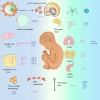The role of macrophage plasticity in neurodegenerative diseases
- PMID: 39135084
- PMCID: PMC11321226
- DOI: 10.1186/s40364-024-00624-7
The role of macrophage plasticity in neurodegenerative diseases
Abstract
Tissue-resident macrophages and recruited macrophages play pivotal roles in innate immunity and the maintenance of brain homeostasis. Investigating the involvement of these macrophage populations in eliciting pathological changes associated with neurodegenerative diseases has been a focal point of research. Dysregulated states of macrophages can compromise clearance mechanisms for pathological proteins such as amyloid-β (Aβ) in Alzheimer's disease (AD) and TDP-43 in Amyotrophic lateral sclerosis (ALS). Additionally, recent evidence suggests that abnormalities in the peripheral clearance of pathological proteins are implicated in the pathogenesis and progression of neurodegenerative diseases. Furthermore, numerous genome-wide association studies have linked genetic risk factors, which alter the functionality of various immune cells, to the accumulation of pathological proteins. This review aims to unravel the intricacies of macrophage biology in both homeostatic conditions and neurodegenerative disorders. To this end, we initially provide an overview of the modifications in receptor and gene expression observed in diverse macrophage subsets throughout development. Subsequently, we outlined the roles of resident macrophages and recruited macrophages in neurodegenerative diseases and the progress of targeted therapy. Finally, we describe the latest advances in macrophage imaging methods and measurement of inflammation, which may provide information and related treatment strategies that hold promise for informing the design of future investigations and therapeutic interventions.
Keywords: Gene expression; Imaging methodologies; Immune cells; Macrophages; Neurodegenerative disease.
© 2024. The Author(s).
Conflict of interest statement
The authors declare no competing interests.
Figures




Similar articles
-
Autophagy and apoptosis dysfunction in neurodegenerative disorders.Prog Neurobiol. 2014 Jan;112:24-49. doi: 10.1016/j.pneurobio.2013.10.004. Epub 2013 Nov 6. Prog Neurobiol. 2014. PMID: 24211851 Review.
-
Inhibition of Smad3 in macrophages promotes Aβ efflux from the brain and thereby ameliorates Alzheimer's pathology.Brain Behav Immun. 2021 Jul;95:154-167. doi: 10.1016/j.bbi.2021.03.013. Epub 2021 Mar 15. Brain Behav Immun. 2021. PMID: 33737172
-
Polyunsaturated Fatty Acids Mend Macrophage Transcriptome, Glycome, and Phenotype in the Patients with Neurodegenerative Diseases, Including Alzheimer's Disease.J Alzheimers Dis. 2023;91(1):245-261. doi: 10.3233/JAD-220764. J Alzheimers Dis. 2023. PMID: 36373322 Free PMC article.
-
Myeloid Arginase 1 Insufficiency Exacerbates Amyloid-β Associated Neurodegenerative Pathways and Glial Signatures in a Mouse Model of Alzheimer's Disease: A Targeted Transcriptome Analysis.Front Immunol. 2021 May 11;12:628156. doi: 10.3389/fimmu.2021.628156. eCollection 2021. Front Immunol. 2021. PMID: 34046031 Free PMC article.
-
The role of innate immunity in Alzheimer's disease.Immunol Rev. 2020 Sep;297(1):225-246. doi: 10.1111/imr.12896. Epub 2020 Jun 26. Immunol Rev. 2020. PMID: 32588460 Free PMC article. Review.
Cited by
-
Topography-based implants for bone regeneration: Design, biological mechanism, and therapeutics.Mater Today Bio. 2025 Jul 13;34:102066. doi: 10.1016/j.mtbio.2025.102066. eCollection 2025 Oct. Mater Today Bio. 2025. PMID: 40735704 Free PMC article. Review.
-
Immunomodulatory Mechanisms Underlying Neurological Manifestations in Long COVID: Implications for Immune-Mediated Neurodegeneration.Int J Mol Sci. 2025 Jun 27;26(13):6214. doi: 10.3390/ijms26136214. Int J Mol Sci. 2025. PMID: 40649991 Free PMC article. Review.
-
Generative artificial intelligence, integrative bioinformatics, and single-cell analysis reveal Alzheimer's genetic and immune landscape.Mol Ther Nucleic Acids. 2025 Apr 24;36(2):102546. doi: 10.1016/j.omtn.2025.102546. eCollection 2025 Jun 10. Mol Ther Nucleic Acids. 2025. PMID: 40496817 Free PMC article.
References
-
- Utz SG, See P, Mildenberger W, Thion MS, Silvin A, Lutz M et al. Early fate defines microglia and non-parenchymal brain macrophage development. Cell. 2020;181:557 – 73.e18. - PubMed
Publication types
Grants and funding
LinkOut - more resources
Full Text Sources
Miscellaneous

